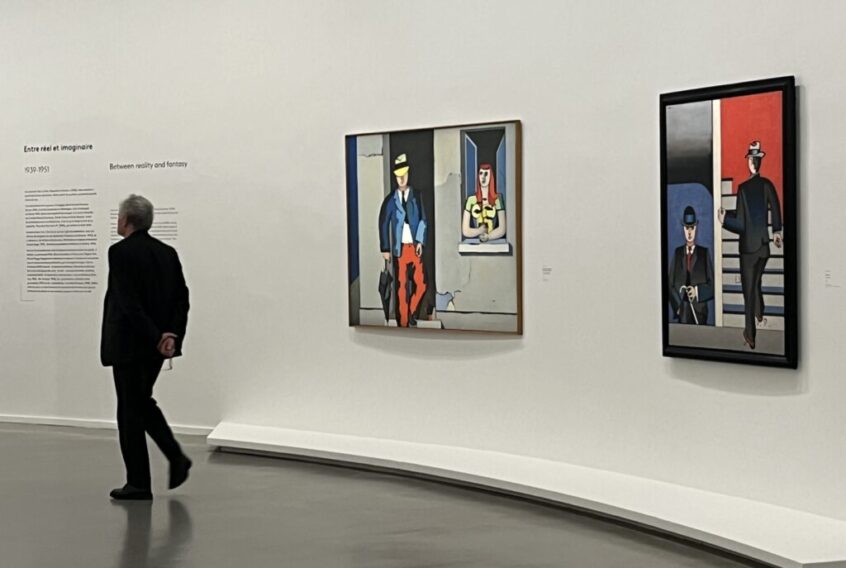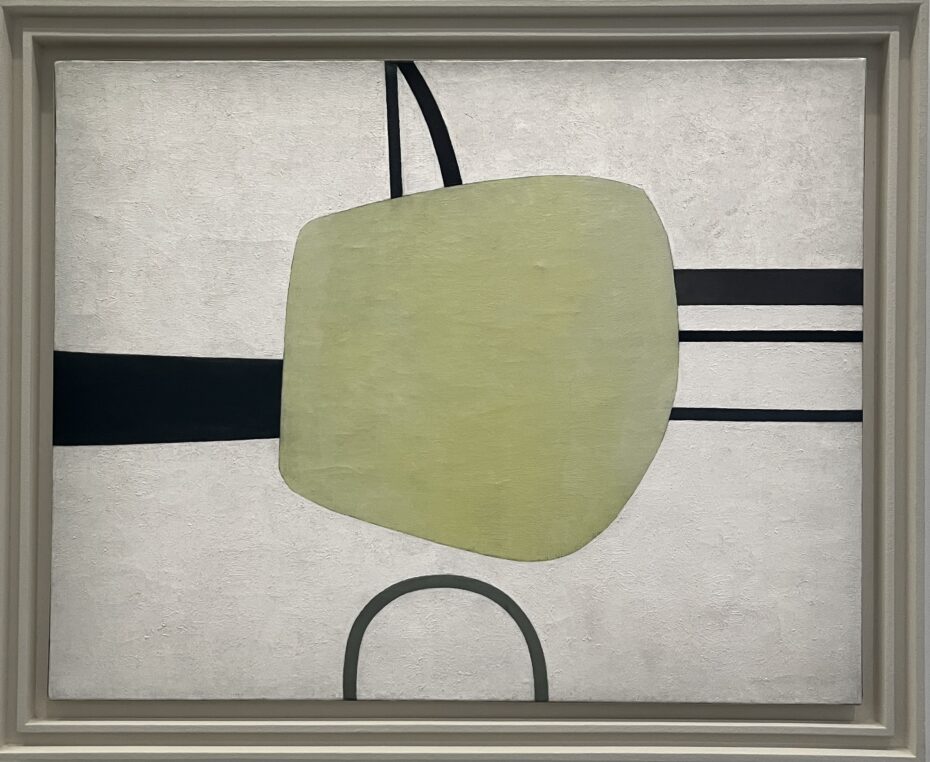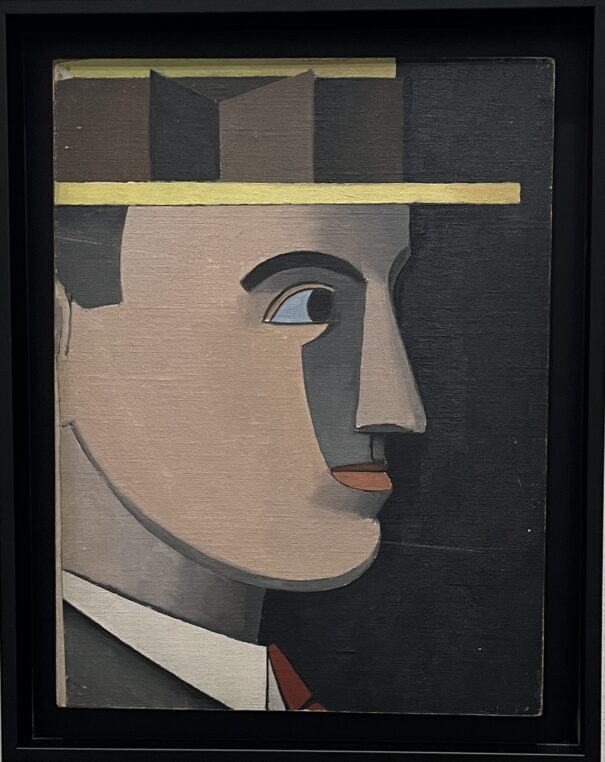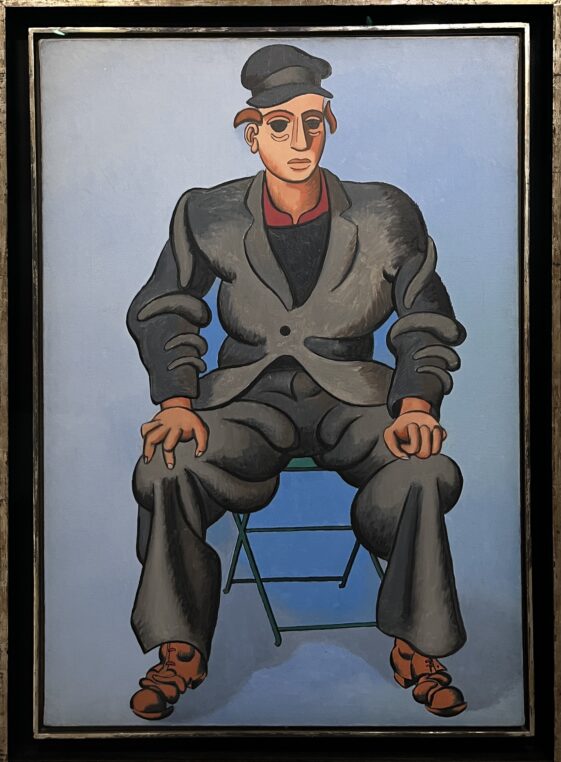It was very exciting to hear Fabrice Hergott, the director of MAM and Henry-Claude Cousseau, the guest curator, discuss their vision of Jean Hélion, 1904-1987, a multifaceted but slightly forgotten artist, who has not been shown in Paris since 2004. This son of peasants, was a great writer and a great charmer and for having met him when he was “a shy young man”, Cousseau declared that he had been fascinated by his magnetism and eloquence. Self taught and made a prisoner in Germany during WWII, he escaped from prison and from himself and tried out various styles, moving from abstraction in France and in the US, where he introduced this new style with art historian Meyer Shapiro, to figuration and realism which Francis Ponge found “gênant”, disturbing.
In his early years in Montparnasse, Hélion met Joaquin Torres Garcia who introduced him to cubism and Piet Mondrian who was a revelation. “Orthogonal composition” painted in 1929-1930 is very reminiscent of him and he expressed his vision of the “Concrete Art Movement”, through the use of horizontal and vertical lines combined with colorful planes. He became close to Alexander Calder and Jean Arp in 1932, started working on equilibrium to “reveal the full plasticity of space”.
“It is strange how much, in my process of reconstructing the world, I sometimes get close to nature, then, by a slight shifting of shapes, how much I depart from it.” This is one of the sentences written on the walls of MAM and they give a nice rhythm to the clever hanging of 103 paintings and more drawings. The variety in styles allows us a gentle promenade with the discovery of “Emile, Edouard and Charles”, three enigmatic men tightly framed.
“Still life with Umbrella” follows, with a few street scenes painted in New York: “The Greeters” take their hats off to say hello in 1945, “The lighter” in blue red and grey is totally disjoined, “Woman leaning on Elbows” in 1946 reminded me of Picasso as did his self-portrait “The Half Nude Painter”. In 1947, he is back in Paris with his wife, Pegeen Vail (daughter of Peggy Guggenheim) and paints “A Rebours” (Backwards) a painting which brings him back to figuration after exploring abstraction. A couple of “Seated men” in blue are superb with their mix of styles and so is “The Man Lying on a Bench” of 1950. This is probably the period that I found most appealing and personal. The room devoted to drawings, shows a very moving self portrait from 1953 and still lives as well as his notebooks lent by the Bnf.
After a few more scenes of “Mannequins in a window in New York” , the major “Triptych of the Dragon” (1967), replaces his project of depicting a city in twelve paintings. He uses acrylic for the first time, and describes it as an attempt to round up the various stages of his life. Designed like a theater stage, the work in three parts, is full of symbols and includes a blind man, a sad premonition of his future state at the end of his life.
I found his later works inspired by May 68 less convincing and in the 1980’s, his “Festival d’Automne at the Studio” is a mix of musical instruments and self portrait as an old and blind man in vivid colors, slightly crazy. He painted it in order to “see clearer”. From then on Dreams replaced reality and the blindness took a metaphorical dimension, freeing him from any plastic conventions. One of the happier images in the last room, is “Ballet of Chairs in Skyros”, painted in 1980 and lent by Clovis Vail.
This is really an uplifting show of a painter who remains fairly unknown since his first retrospective at Sables d’Olonne in the 1970’s. It took two years to prepare and the curators realized how much he was loved by contemporary painters such as Peter Doig who considers him as a reference. In their introduction, they kept on saying that it was not an easy work because of his very personal style. I found the exhibition very amusing and joyful and I am sure that the young public will be impressed and enjoy it immensely.
His wife Jacqueline and their two sons visited the show the day before the opening. MAM Paris until August 18.
Share this Post






